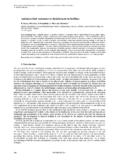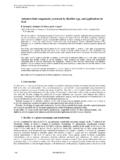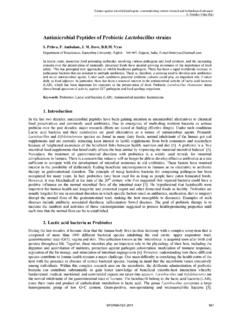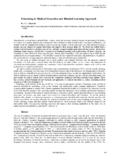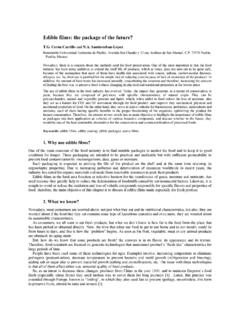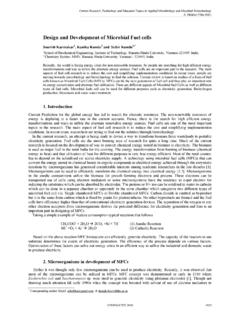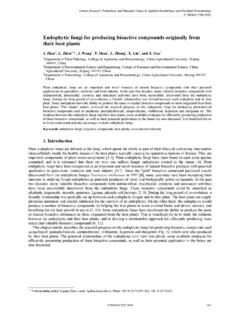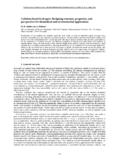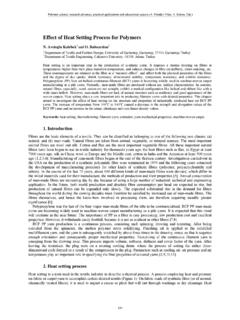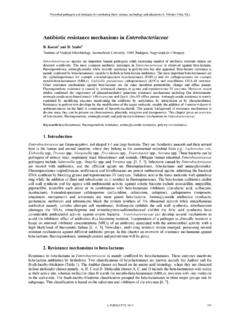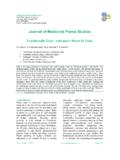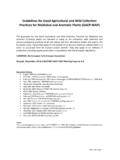Transcription of Control of plant diseases using extracts from …
1 Science against microbial pathogens: communicating current research and technological advances _____. A. M ndez-Vilas (Ed.). Control of plant diseases using extracts from medicinal plants and fungi J. R. Stangarlin1, O. J. Kuhn1, L. Assi1, K. R. F. Schwan-Estrada2. 1. Western Paran State University UNIOESTE, Rua Pernambuco 1777, Caixa Postal 91, CEP 85960-000, Marechal C ndido Rondon, Paran , Brazil. E-mail: 2. Maring State University UEM, Av. Colombo 5790, CEP 87020-900, Maring , Paran , Brazil Actually, with the objective to find new technologies, ecologically or environmentally safer, for the Control of plant diseases , mainly in organic growth, alternative methods for the Control of phytopathogens are been development.
2 This kind of alternative methods are been investigated in our Biological and Alternative Control of plant diseases ' research group. An overview of the our researches using medicinal plants and fungal extracts for the plant disease Control in the last 10. years and examples of in vitro and field essays are presented. Keywords resistance induction; alternative Control ; botanical formulation; organic growth 1. Introduction The intensive and indiscriminate use of pesticides in agriculture has caused many problems to the environment such as water, soil, animals and food contamination; poisoning of farmers; elimination of non-target organisms; and selection of phytopathogens, pest and weed insensitive to certain active ingredients [1].
3 Aiming to minimize the negative effects of pesticides are been development the alternative Control of plant disease , which includes the biological Control , the induction of resistance and the use of natural products with induction of resistance and/or with direct antimicrobial activities. In the latter include the use of extracts and essential oils from medicinal plants [1, 2], as well as the extracts obtained from basidiomycetes [3, 4, 5, 6, 7]. The biological Control is defined as the use of antagonistic organisms for the Control of microorganisms, reducing the amount of inoculum that determines the extent of disease [8].
4 The induction of resistance promotes the activation of the latent plant defense systems, which manifests itself when it comes into contact with a biotic [9, 10, 11, 12, 13] or abiotic elicitor [14, 15]. The expression resistance of induction both can be used to denote local protection, this is, the induction of a resistance only in the tissues in which it was applied the treatment with the inducing agent, also can indicate a systemic resistance that manifest far from the tissue where the elicitor was applied [16]. 2. Medicinal plant extracts plant extracts used to Control of the phytopathogens have been obtained mainly from tree species such as eucalyptus and neem (24% of the studies with extracts ) and herbaceous species like garlic, citronella, mint, rue, yarrow, ginger, basil, camphor, turmeric and ocimum (54%).
5 Besides these there are other 237 plants from the Brazilian flora whose antimicrobial potential was tested by Brazilian researchers. With respect to groups of pathogens, the majority of the work is with those that cause disease in the plant canopy (30% of the works with extracts ), like the genus Alternaria, Bipolaris, Crinipellis, Corynespora and Colletotrichum, which respond alone for 15% of the works. The soil-born pathogens represent 20% of the researches, especially Rhizoctonia, Sclerotium, Sclerotinia, Fusarium and Phytophthora. Post-harvest pathogens like Penicillium, Aspergillus and Rhizopus are in 9% of the works and Meloidogyne nematode in For the host plants , 30% of the work are with crops like beans, soybeans, coffee, wheat, cotton and cassava; 20% with vegetables like cucumber and tomato, this later representing alone 15% of all the researches with extract; and 10% with the fruits like papaya, strawberry and cocoa.
6 Details about these data can be found in the review of Stangarlin and colleagues [11]. From these presented numbers we can have an overview of the researches on alternative Control of disease in plants in Brazil using natural extracts . Besides that, other researches have been made to identify plants whose extracts have compounds with biological action against phytopathogens or that induce plant resistance. Some of these works are detailed below, focusing mainly the results published of the research group Biological and Alternative Control of plant diseases - COBALFI (Western Paran State University - UNIOESTE campus Marechal C ndido Rondon, Brazil).
7 Artemisia camphorata (camphor). Aqueous extract (AE) of camphor was used to evaluate the fungitoxic activity against Bipolaris sorokiniana and the induction of resistance to black point wheat. The AE in concentrations of 1, 5, 10, 15, 20, 25 and 50% was prepared with antioxidant (Na2SO3 ) or not, and autoclaved or not autoclaved. To evaluate induction of resistance against FORMATEX 2011 1033. Science against microbial pathogens: communicating current research and technological advances _____. A. M ndez-Vilas (Ed.). black point disease , wheat plants with 30 days were sprayed with AE.
8 At 24, 48 and 72 h after the treatments, the leaves were inoculated with the pathogen (1x104 conidia/mL). The AE 50% caused 39% of mycelial growth inhibition. The AE 10% totally inhibited the fungus sporulation in vitro. The AE not autoclaved inhibited only 20% of the conidia germination but the autoclaved AE did not cause inhibition showing the presence of thermo-sensible compounds. The incorporation of antioxidant Na2SO3 in the AE increased the inhibition of conidia germination. The AE of camphor also induced systemic resistance in wheat plants , reducing the size (up to 29%) and the number of spots (up to 60%).
9 The induction was higher in plants treated with camphor 72 h before the inoculation with pathogen [17]. To evaluate the post-harvest Control of anthracnose in banana, an in vitro assay was conduced to measured the mycelial growth of Colletotrichum musae in solid and liquid media containing 1, 5, 10, 15, 20 and 25% of camphor (fresh weigh/volume). To in vivo assay was evaluated the post-harvest Control by immersing banana fruits for 3 min in the camphor extracts , using as Control treatments Benomyl ( g/L) and distillated water. The results showed that camphor inhibited 41% the mycelial growth and 86% the sporulation, in solid medium, although had stimulated the mycelial growth in liquid medium.
10 The severity of anthracnose was reduced to 67% and 56% for camphor and fungicide treatments, respectively [18]. Curcuma longa (turmeric). Control of Xanthomonas axonopodis pv. manihotis The Control of cassava bacterial wilt was evaluated in vitro by using aqueous extract of four turmeric genotypes from Jaboticabal-SP, Mara Rosa-GO, Maring -PR and Mercedes-PR, as well as in vivo, by treatment of infected cassava stems and their cultivation at field conditions. The results showed that in vitro experiment, turmeric extract inhibited completely the bacteria growth in the concentration of 10% for the genotype from Mercedes, while for the Jaboticabal's turmeric there was a total Control at 15% and for Mara Rosa at 20%.
